|
FAQs about Linckia Sea Star
Identification
Related Articles: Linckia Stars, Asterina Stars, An Introduction to the
Echinoderms: The Sea Stars, Sea Urchins, Sea Cucumbers and
More... By James W. Fatherree, M.Sc.
Related FAQs: Seastar ID 1, Linckia Stars 1, Linckia Stars 2, Linckia Behavior, Linckia Compatibility, Linckia Selection, Linckia Systems, Linckia Feeding, Linckia Disease, Linckia Reproduction, Sea Stars 1, Sea
Stars 2, Sea Stars 3, Sea Stars 4, Sea
Stars 5, Seastar Selection,
Seastar Compatibility, Seastar Systems, Seastar Behavior, Seastar Feeding, Seastar Reproduction, Seastar Disease, Asterina
Stars, Chocolate Chip Stars,
Crown of Thorns Stars,
Fromia Stars,
Sand-Sifting
Stars,
|
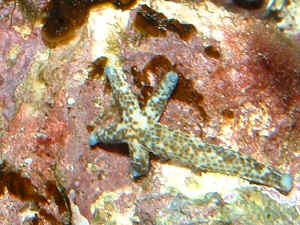
|
|
Sea star ID 9/23/13
This guy hitch hiked a ride on some live rock we purchased a few months
ago. He has been growing slowly but surely. We recently upgraded our
tank and shortly after the move I noticed he had lost an arm. I have 2
questions, what sort of sea star is this, and how likely is
it that the arm will become another star?
<Might be a Linckia sp. See here:
http://www.wetwebmedia.com/Seastars3.htm
Re the other arm... maybe>
I have included a couple of photos. The arm is moving slowly around
the tank and both the arm and the star are much more active at night.
Thanks for your help.
<Use, search WWM and read re these animals. Bob Fenner>
|
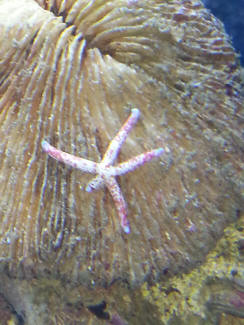
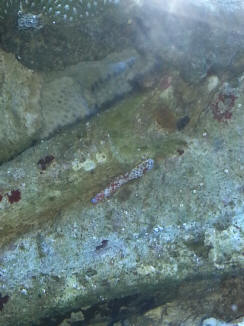 |
|
Unknown Asteroidean, ID, sel. 11/13/09
Hello WWM Crew,
<Scott>
I recently encountered a sea star at a reputable LFS that I am
hoping will be suitable for long term survival in my display. The
store manager told me that they found it in a live rock shipment
(most likely from the South Pacific) and they decided to see if
it would survive in one of their displays (a small mini reef
setup).
<Okay>
After four months at the LFS, the sea star seemed to be very
healthy and appeared to be regenerating previous damage to a
couple of its arms. My best guess at the time was that it was a
Linckia species and had a good chance of survival in my (four
years mature) 135 gallon SPS display. So in spite of concerns
about difficulty keeping this animal healthy long term, I decided
to give it my best efforts.
<Mmm, have taken a cursory look on WWM, and the Net... and I
swear I've seen this species somewhere... but don't think
it is of the genus Linckia... But the fact that it has prospered
in captive conditions bodes well>
After acclimation, quarantine and introduction to the display, I
had a chance to take the attached photo, with the hope you might
be able to help confirm the ID. My "novice" best guess
is Linckia multifora. Would you kindly advise your opinion on
this?
<Please try to match here:
http://wetwebmedia.com/seastars2.htm
or send along a link to a graphic that matches the body
conformation, colour, markings>
Apart from maintaining a healthy display for "grazing",
is there anything else you would do to insure this guy has the
best chance for long term survival, say for example some type of
target feeding?
<Experiment with various food stuffs... was this Echinoderm
fed anything specifically by the dealer?>
As always, I truly appreciate you folks and the service provided
by your invaluable website.
Scott
<Thank you, and thank you for sharing, contributing, being
part of it. Bob Fenner>
L. guildi does appear to be the closest match
11/13/09
Scotter, I've woken up a bit (finished my Java...) and I do
think you are right... re this ID... L. guildi does appear to be
the closest match. BobF
|
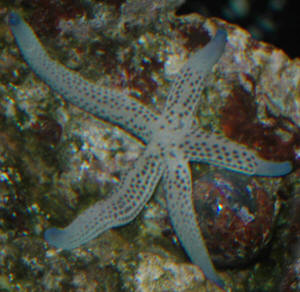 |
Purple Linckia (actually a Tamaria stria) Have a
3" star that I got at local pet store 3-4 weeks ago. It has 6
legs, but from your description & pics on your sites, it is a
purple. Has been spotless & active. Anyhow, 3 days ago I noticed a
tiny mass of dingy white, translucent stuff on the top of its central
disk. Star is so small that I'm not sure, but it seemed to have
been attached to its madreporite or its "anus". The following
day it had developed a few very small white spots on 2 of its legs
close to the central disk, and yesterday I saw that there are real
small areas of missing flesh (vacu...something?) around these spots. No
rotting flesh...yet. It's still active as ever, but has pretty much
lost use of its worst affected arm. After reading other e-mails to you,
I don't have much hope. And it was so dang adorable! Thank you for
you time...Tammy <indeed...bad signs. You might try abrading the
soft tissue areas in a bucket of seawater (then disposing) with a soft
toothbrush. A short dip with reef iodine at double dose might be
therapeutic too. Focus on very good water quality (skimming, water
changes, chemical filters) and lets hope for the best. Anthony>
Red Linckia Starfish? Hello is there such thing as
a red Linckia? <Probably Echinaster luzonicus or a Fromia sp.> I
just bought one but can't find any info <You didn't just buy
something you didn't know how to care for, did you? Don't make
me yell at you. :) > looks just like the blue Linckia but red. Any
info? <Take a look here http://www.wetwebmedia.com/seastars.htm I
usually just let my blue Linckia eat whatever he finds, but I
occasionally feed him a piece of frozen Formula food.> Thanks in
advance <You are welcome. -Steven Pro>
| Re: unknown star fish Bob, A while back I
asked you about a star fish I had come to me by way of a candy cane
coral I purchased. You said you didn't have a clue what kind it
was from my description because there are so many different
starfish. Well as luck would have it I got a digital camera for
Christmas, so here is a picture of the little bugger. So as the man
on the game show would say...Bob Fenner...name that star fish :)
Thanks, Robert <Tah dah! It's a Linckia multifora. Please
see here: http://www.wetwebmedia.com/seastars.htm
Bob Fenner> |
|
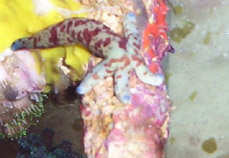
|
Linckia Stars Dear Crew; I have searched your
website many times over the years and I think it is an awesome site.
<Thank You> Anyway, my question is what kind of sea star do I
have. I purchased a sea star a couple of days ago that the dealer said
was a Blue Linckia and I suppose it could be. But it is not blue it is
a bluish green color with some mottling on it and blue tips on each of
the arms. Otherwise it does look like a Linckia sea star but I don'
t know if it actually is Linckia laevigata. Please help. The sea star
is fine by the way. <There are many types of Linckia stars. Without
a pic of it I could not give you a good answer. Do a search on the WWM,
keyword, Linckia starfish, and see if you can find a pic of it. James
(Salty Dog)> Thanks,
James <Nice name>
| - ID This - Sorry, I just learned that AOL
made me zip 'em. <No worries...> Hello- <Oh,
hello.> I am new to marine aquarium keeping and I have found a
new creature on the live rock that I (or anyone else I know) am
unable to identify. A picture is attached. It looks similar to a
star fish having one extra long leg. <That's exactly what it
is, perhaps a Linckia... seastars have an amazing regenerative
capability... this star was probably reduced to just a portion of
the disk and the one leg, and it's just been slowly growing
back the missing parts. Neat acquisition.> It is about 1.5"
in length. The system has been running almost a month. The live
rock was added during the 2nd week. Everything seems to be going
well, in my humble opinion. I would like to know what this creature
is and if it will harm other organisms. <Probably nothing to
worry about... some seastars make a habit of eating bi-valves, but
others are less predatory. I'd keep it around.> I find your
website very informative. Thanks for all your <Cheers, J --
> |
 |
|
|

